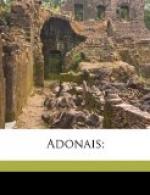1. 5. Thunder-smoke, whose skirts were chrysolite. Technically, chrysolite is synonymous with the precious stone peridot, or olivine—its tint is a yellowish green. But probably Shelley thought only of the primary meaning of the word chrysolite, ‘golden-stone,’ and his phrase as a whole comes to much the same thing as ’a cloud with a golden lining.’
+Stanza 6,+ 1. 1. And like a sudden meteor. We here have a fragmentary simile which may—or equally well may not—follow on as connected with St. 5. See on p. 147, for whatever it may be worth in illustration, the line relating to Coleridge:—
‘A cloud-encircled meteor of the air.’
1. 5. Pavilioned in its tent of light. Shelley was fond of the word Pavilion, whether as substantive or as verb. See St. 50: ’Pavilioning the dust of him,’ &c.
FOOTNOTES:
[1] See the Life of Mrs. Shelley, by Lucy Madox Rossetti (Eminent Women Series), published in 1890. The connexion between the two branches of the Shelley family is also set forth—incidentally, but with perfect distinctness—in Collins’s Peerage of England(1756), vol. iii. p. 119. He says that Viscount Lumley (who died at some date towards 1670) ’married Frances, daughter of Henry Shelley, of Warminghurst in Sussex, Esq. (a younger branch of the family seated at Michaelgrove, the seat of the present Sir John Shelley, Bart.).’
[2] I am indebted to Mr. J. Cordy Jeaffreson for some strongly reasoned arguments, in private-correspondence, tending to Harriet’s disculpation.
[3] This line (should be ‘Beneath the good,’ &c.) is the final line of Gray’s Progress of Poesy. The sense in which Shelley intends to apply it to The Cenci may admit of some doubt. He seems to mean that The Cenci is not equal to really good tragedies; but still is superior to some tragedies which have recently appeared, and which bad critics have dubbed great.
[4] This phrase is not very clear to me. From the context ensuing, it might seem that the ‘circumstance’ which prevented Keats from staying with Shelley in Pisa was that his nerves were in so irritable a state as to prompt him to move from place to place in Italy rather than fix in any particular city or house.
[5] Though Shelley gave this advice, which was anything but unsound, he is said to have taken good-naturedly some steps with a view to getting the volume printed. Mr. John Dix, writing in 1846, says: ’He [Shelley] went to Charles Richards, the printer in St. Martin’s Lane, when quite young, about the printing a little volume of Keats’s first poems.’
[6] This statement is not correct—so far at least as the longer poems in the volume are concerned. Isabella indeed was finished by April, 1818; but Hyperion was not relinquished till late in 1819, and the Eve of St. Agnes and Lamia were probably not even begun till 1819.




